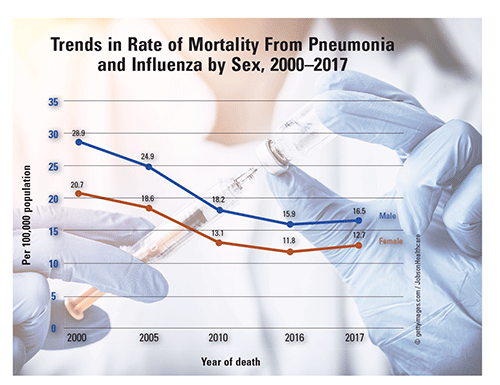US Pharm. 2020;45(4):15.
In 2017, approximately one-half million emergency department visits were made for influenza and 1.7 million visits were made for pneumonia. In patients who were hospitalized for influenza A, comorbid respiratory disease led to pneumonia in 65.7% of cases. In 2019, according to the CDC, 68.9% and 68.1% of persons aged >65 years were vaccinated for pneumonia and influenza, respectively. In that year, 4.6% more females than males were vaccinated for pneumonia, and the rate was similar for influenza vaccination.

Influenza Vaccination: The CDC estimates that 45.3% of persons in the United States were vaccinated for influenza from 2018 to 2019, a higher rate than in 2017 to 2018 and 2016 to 2017, and this trend was mirrored in different age groups. From 2018 to 2019, 62.6% of children aged <18 years were vaccinated, and with age the rate of vaccination decreased. From 2010 to 2017, the vaccination rate for adults aged 18 to 49 years, 50 to 64 years, and 65 years or older remained relatively stable, averaging 32%, 45%, and 65.4%, respectively. Although from 2017 to 2018 vaccination rates dropped significantly (by 16%, 11.8%, and 8.9%, respectively) in those aged 18 to 49 years, 50 to 64 years, and 65 years or older, from 2018 to 2019 the rate increased by 29.7%, 19.1%, and 14.1%, for a prevalence of 34.9%, 47.3%, and 68.1, respectively.
Mortality Rates by Sex: Even though mortality rates for both influenza and pneumonia declined overall from 2000 to 2017, the rates of decline differed somewhat in males and females across this time period. Compared with males (27%), females (29.6%) had a 9.6% greater decrease in mortality rate between 2005 and 2010. During the other years—that is, 2000 to 2005 and 2010 to 2016—males and females had the same rank ordering of decline (although of different magnitude) in mortality rates for influenza and pneumonia. Surprisingly, however, the decline reversed, and from 2017 to 2018 the rate doubled in females (7.6%) versus males (3.8%).
Mortality Rates by Ethnicity: For rates of mortality due to influenza and pneumonia from 2000 to 2017, ethnic groups maintained the same rank order in nearly all cases. Hispanics had the greatest drop in mortality rate (13.4%) from 2000 to 2017, followed by non-Hispanic blacks (11.7%), American Indian/Alaska Natives (11%), non-Hispanic whites (10.6%), and Asian/Pacific Islanders (9.7%). Of all declines in mortality rates across ethnicities from 2000 to 2017, the single largest decrease (32.6%) was found in American Indian/Alaska Natives between 2005 and 2010; the smallest decrease (1.3%) occurred in non-Hispanic blacks from 2016 to 2017.
To comment on this article, contact rdavidson@uspharmacist.com.






